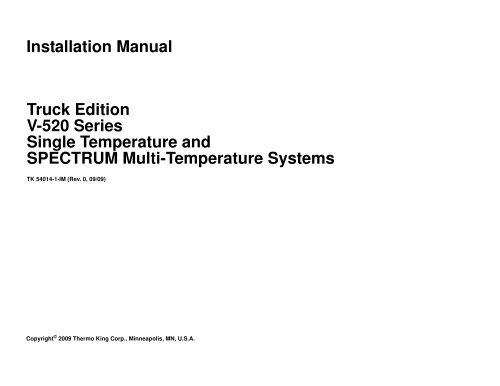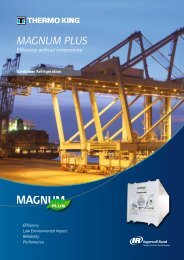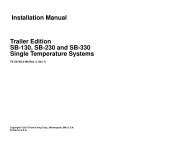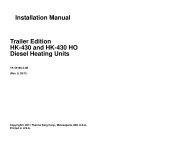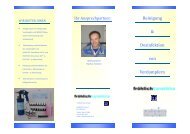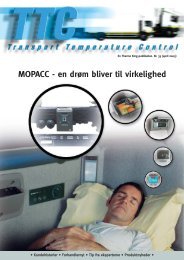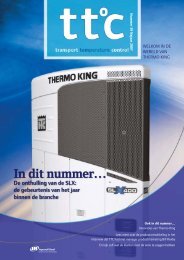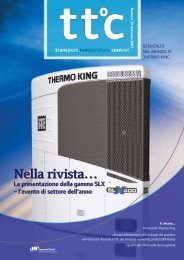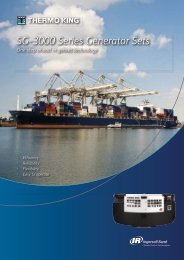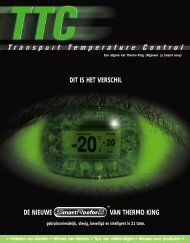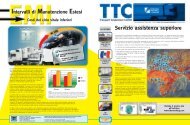Installation Manual Truck Edition V-520 Series Single ... - Thermo King
Installation Manual Truck Edition V-520 Series Single ... - Thermo King
Installation Manual Truck Edition V-520 Series Single ... - Thermo King
You also want an ePaper? Increase the reach of your titles
YUMPU automatically turns print PDFs into web optimized ePapers that Google loves.
<strong>Installation</strong> <strong>Manual</strong><br />
<strong>Truck</strong> <strong>Edition</strong><br />
V-<strong>520</strong> <strong>Series</strong><br />
<strong>Single</strong> Temperature and<br />
SPECTRUM Multi-Temperature Systems<br />
TK 54014-1-IM (Rev. 0, 09/09)<br />
Copyright © 2009 <strong>Thermo</strong> <strong>King</strong> Corp., Minneapolis, MN, U.S.A.
Release History<br />
Released (09/09)<br />
2
This manual was written to assist with the installation of a <strong>Thermo</strong> <strong>King</strong><br />
V-<strong>520</strong> condenser unit with ES-300 or ES-500 remote evaporators onto<br />
trucks designed and built for refrigerated applications. Due to its<br />
complexity, you should not attempt this installation unless you:<br />
• Are an experienced mechanic.<br />
• Can safely lift 34 kilos (75 lbs.)<br />
• Are certified or trained in the repair and maintenance of transport<br />
refrigeration systems.<br />
• Have a basic understanding of electricity and electrical wiring.<br />
• Have the necessary tools and equipment to complete the installation<br />
• Have a truck body designed and built to meet the requirements of this<br />
installation.<br />
Introduction<br />
This manual is published for informational purposes only. <strong>Thermo</strong> <strong>King</strong> makes no representations warranties express or implied, with respect to<br />
the information recommendations and descriptions contained herein. Information provided should not be regarded as all-inclusive or covering<br />
all contingencies. If further information is required, <strong>Thermo</strong> <strong>King</strong> Corporation Service Department should be consulted.<br />
<strong>Thermo</strong> <strong>King</strong>’s warranty shall not apply to any equipment which has been “so installed, maintained, repaired or altered as, in the manufacturer’s<br />
judgment, to affect its integrity.”<br />
Manufacturer shall have no liability to any person or entity for any personal injury, property damage or any other direct, indirect,<br />
special, or consequential damages whatsoever, arising out of the use of this manual or any information, recommendations or<br />
descriptions contained herein.<br />
3
Safety Precautions . . . . . . . . . . . . . . . . . . . . . . . . . . . . . . . . . . . . . . . . . . . . . . .6<br />
Tips for a Successful <strong>Installation</strong> . . . . . . . . . . . . . . . . . . . . . . . . . . . . . . . . . . 8<br />
Required Tools . . . . . . . . . . . . . . . . . . . . . . . . . . . . . . . . . . . . . . . . . . . . . . . . .10<br />
V-<strong>520</strong> Dimensions and Weights . . . . . . . . . . . . . . . . . . . . . . . . . . . . . . . . . . . 12<br />
ES-300 Evaporator Dimensions and Weight . . . . . . . . . . . . . . . . . . . . . . . . .13<br />
ES-500 Evaporator Dimension and Weight. . . . . . . . . . . . . . . . . . . . . . . . . . 14<br />
In-Cab Controller Dimensions . . . . . . . . . . . . . . . . . . . . . . . . . . . . . . . . . . . . .15<br />
<strong>Installation</strong> - Vehicle Powered Compressor . . . . . . . . . . . . . . . . . . . . . . . . . .16<br />
<strong>Installation</strong> - V-<strong>520</strong> Condenser . . . . . . . . . . . . . . . . . . . . . . . . . . . . . . . . . . . .18<br />
<strong>Installation</strong> - (1) ES-500 Evaporator. . . . . . . . . . . . . . . . . . . . . . . . . . . . . . . . 20<br />
<strong>Installation</strong> - (2) ES-300 Evaporators . . . . . . . . . . . . . . . . . . . . . . . . . . . . . . .22<br />
Fabricating Refrigeration Hoses . . . . . . . . . . . . . . . . . . . . . . . . . . . . . . . . . . 24<br />
<strong>Installation</strong> - Refrigeration Hoses to Vehicle Powered Compressor . . . . . 30<br />
<strong>Installation</strong> - Jet Cool System . . . . . . . . . . . . . . . . . . . . . . . . . . . . . . . . . . . . .32<br />
Table of Contents<br />
<strong>Installation</strong> - Refrigeration Hoses to Condenser Unit . . . . . . . . . . . . . . . . . 34<br />
<strong>Installation</strong> - Refrigeration Hoses to Evaporator(s) . . . . . . . . . . . . . . . . . . . 38<br />
System Leak Check and Evacuation . . . . . . . . . . . . . . . . . . . . . . . . . . . . . . . 42<br />
Electrical Connections - Evaporator(s) . . . . . . . . . . . . . . . . . . . . . . . . . . . . . 44<br />
<strong>Installation</strong> - Drain Hoses . . . . . . . . . . . . . . . . . . . . . . . . . . . . . . . . . . . . . . . . 48<br />
<strong>Installation</strong> - In-Cab Controller . . . . . . . . . . . . . . . . . . . . . . . . . . . . . . . . . . . . 52<br />
<strong>Installation</strong> - Electric Standby Power Supply (20 Models Only) . . . . . . . . . 54<br />
Electrical Connections - Engine Compartment . . . . . . . . . . . . . . . . . . . . . . . 56<br />
System Charging . . . . . . . . . . . . . . . . . . . . . . . . . . . . . . . . . . . . . . . . . . . . . . . 58<br />
CPR Valve Adjustment Procedures . . . . . . . . . . . . . . . . . . . . . . . . . . . . . . . . 60<br />
<strong>Installation</strong> Check List . . . . . . . . . . . . . . . . . . . . . . . . . . . . . . . . . . . . . . . . . . 61<br />
Electric Standby Power Receptacle Wiring (20 Models Only) . . . . . . . . . . . 62<br />
Wiring Diagram and Wiring Schematic Drawing Numbers . . . . . . . . . . . . . 63<br />
4
Recover Refrigerant<br />
At <strong>Thermo</strong> <strong>King</strong>, we recognize the need to preserve the environment and limit the potential harm to the ozone layer that<br />
can result from allowing refrigerant to escape into the atmosphere.<br />
We strictly adhere to a policy that promotes the recovery and limits the loss of refrigerant into the atmosphere.<br />
In addition, service personnel must be aware of Federal regulations concerning the use of refrigerants and the certification<br />
of technicians. For additional information on regulations and technician certification programs, contact your local<br />
THERMO KING dealer.<br />
R-404A/R-134a<br />
WARNING: Use ONLY Polyol Ester based refrigeration compressor oil<br />
(TK P/N 203-513) in R-404A and R-134a units.<br />
DO NOT use Polyol Ester based oil in standard <strong>Thermo</strong> <strong>King</strong> units.<br />
DO NOT mix Polyol Ester and standard synthetic compressor oils.<br />
Keep Polyol Ester compressor oil in tightly sealed containers. If Polyol Ester oil becomes contaminated with moisture<br />
or standard oils, dispose of properly—DO NOT USE!<br />
WARNING: When servicing <strong>Thermo</strong> <strong>King</strong> R-404A and R-134a units, use only those service tools certified for and<br />
dedicated to R-404A or R-134a refrigerant and Polyol Ester compressor oils. Residual non-HFC refrigerants or oils will<br />
contaminate R-404A and R-134a systems.<br />
CAUTION<br />
<strong>Thermo</strong> <strong>King</strong> condenser units and remote evaporators are shipped with a 35 kPa (5 psi) holding charge of Helium. This<br />
holding charge may be safely vented into the atmosphere.<br />
CAUTION: SEVERE COMPRESSOR DAMAGE will result from operating the unit before completing the installation<br />
which includes: installing the components, releasing the holding charge, connecting refrigeration lines, leak testing,<br />
evacuation, clean-up and charging of the system with the proper amount and type of refrigerant.<br />
5
DANGER: Never operate the unit with the discharge valve closed<br />
as it could cause the compressor to explode, causing death or<br />
serious injury.<br />
DANGER: Never apply heat to a sealed refrigeration system or<br />
container because it could explode, causing death or serious<br />
injury.<br />
DANGER: Fluorocarbon refrigerants, in the presence of an open<br />
flame or electrical short, produce toxic gases that are severe<br />
respiratory irritants capable of causing death.<br />
DANGER: Be careful when working with a refrigerant or<br />
refrigeration system in any enclosed or confined area with a<br />
limited air supply (i.e., a trailer, container or the hold of a ship).<br />
Refrigerant tends to displace air and can cause oxygen depletion<br />
which may result in death by suffocation.<br />
Safety Precautions<br />
The symbol appears next to a point that is particularly important:<br />
DANGER: Addresses a circumstance that, if encountered, will<br />
lead to death or serious injury.<br />
WARNING: Addresses a circumstance that, if encountered, might<br />
lead to death or serious injury.<br />
CAUTION: Addresses a circumstance that, if encountered, may<br />
cause damage to equipment or minor injury.<br />
WARNING: Always wear eye protection such as goggles or safety<br />
glasses. Refrigerant liquid, refrigeration oil, and battery acid can<br />
permanently damage the eyes (see First Aid under Refrigeration<br />
Oil).<br />
WARNING: Keep your hands away from fans when the unit is<br />
running. This should also be considered when opening and<br />
closing the compressor service valves.<br />
WARNING: Make sure gauge manifold hoses are in good<br />
condition. Never let them come in contact with a belt, fan motor<br />
pulley, or any hot surface.<br />
WARNING: Make sure all mounting bolts are tight and are of<br />
correct length for their particular application.<br />
6
WARNING: Never drill holes in the unit unless absolutely<br />
necessary. Holes drilled into the unit may weaken structural<br />
components. Holes drilled into electrical wiring can cause fire or<br />
explosion.<br />
WARNING: When using ladders to install or service refrigeration<br />
systems, always observe the ladder manufacturer’s safety labels<br />
and warnings. A work platform is the recommended method for<br />
installations.<br />
WARNING: Exposed coil fins are very sharp and can cause<br />
painful lacerations.<br />
Safety Precautions<br />
Refrigerant<br />
WARNING: Although fluorocarbon refrigerants are classified as<br />
safe refrigerants, certain precautions must be observed when<br />
handling them or servicing a unit in which they are used. When<br />
released to the atmosphere in the liquid state, fluorocarbon<br />
refrigerants evaporate rapidly, freezing anything they contact.<br />
First Aid<br />
• FROSTBITE: In the event of frost bite, the objectives of First Aid are<br />
to protect the frozen area from further injury, to warm the affected area<br />
rapidly and to maintain respiration.<br />
• EYES: For contact with liquid, immediately flush eyes with large<br />
amounts of water and get prompt medical attention.<br />
• SKIN: Flush area with large amounts of lukewarm water. Do not apply<br />
heat. Remove contaminated clothing and shoes. Wrap burns with dry,<br />
sterile, bulky dressing to protect from infection/injury. Get medical<br />
attention. Wash contaminated clothing before reuse.<br />
• INHALATION: Move victim to fresh air and use CPR or<br />
mouth-to-mouth ventilation, if necessary. Stay with victim until arrival<br />
of emergency medical personnel.<br />
Refrigeration Oil<br />
WARNING: Avoid refrigeration oil contact with the eyes. Avoid<br />
prolonged or repeated contact of refrigeration oil with skin or<br />
clothing. Wash thoroughly after handling refrigeration oil to<br />
prevent irritation.<br />
First Aid<br />
In case of eye contact, immediately flush with plenty of water for at least<br />
15 minutes. CALL A PHYSICIAN. Wash skin with soap and water.<br />
7
GENERAL INFORMATION<br />
• Read this <strong>Installation</strong> <strong>Manual</strong> to understand how components are to be<br />
located and properly installed.<br />
• The vehicle’s cargo box must be designed and built for refrigeration<br />
applications with insulated walls, ceilings and floors. All cargo box<br />
doors must close and seal tightly.<br />
• The front wall of the cargo box must be able to adequately support the<br />
weight of the V-<strong>520</strong> condenser. Additional supports (installer supplied)<br />
may be required.<br />
• The compartment ceiling of the cargo box must be able to adequately<br />
support the weight of the ES-300 or ES-500 evaporators. Additional<br />
ceiling supports (installer supplied) may be required.<br />
• Verify tools and special equipment required for the installation are<br />
available and in good operating condition.<br />
• Verify all measurements before drilling any mounting holes in the<br />
vehicle.<br />
• Verify there is no interference with any OEM electrical wiring, internal<br />
supports, etc. before drilling any mounting holes in the vehicle.<br />
• Provide protection to the vehicle’s finish to prevent damage during the<br />
installation process.<br />
• Install all components using the correct hardware and tighten securely.<br />
• All access holes through the cargo box must be sealed with silicone<br />
caulking to prevent moisture or air leakage.<br />
• Always use protective grommets when routing electrical harnesses or<br />
refrigeration hoses through sheet metal floors or walls.<br />
• Always keep electrical harness and refrigeration hoses from rubbing or<br />
chafing against sharp metal objects or rotating components.<br />
• The fabrication and installation (by the installer) of protective covers<br />
for any exposed refrigerant hoses and electrical wiring inside or outside<br />
the cargo box is recommended.<br />
Tips for a Successful <strong>Installation</strong><br />
V-<strong>520</strong> CONDENSER<br />
• Check clearance for tilt cab applications before installing the V-<strong>520</strong><br />
condenser.<br />
• Never install any compressible washers or other materials between the<br />
condenser and the cargo box.<br />
ES-300 and ES-500 EVAPORATORS<br />
• Verify the evaporator air outlet is facing the correct direction for proper<br />
airflow before installing.<br />
• Allow a minimum distance of 6.00 in. (152 mm) from the cargo box<br />
wall to the rear of the evaporator for refrigerant hose and drain hose<br />
connections.<br />
• Always install the orifice screen correctly into the expansion valve of<br />
the evaporator before installing the refrigeration hoses.<br />
• Evaporator drain hoses should be installed and routed correctly with no<br />
kinks or sharp bends to provide for proper drainage.<br />
REFRIGERATION HOSES<br />
• Always keep refrigeration system fittings capped and sealed until the<br />
installation of the refrigeration hoses.<br />
• Only cut refrigerant hoses with the correct hose cutting tool (204-677).<br />
NEVER USE A SAW!<br />
• Always use the correct hose fitting tool (204-1045 or 204-1128) when<br />
assembling refrigerations hoses.<br />
• Always lubricate hose fittings with refrigerant oil when assembling to<br />
refrigeration hoses.<br />
• Always install and lubricate o-rings with refrigerant oil when<br />
connecting refrigeration hose fittings to component connections.<br />
• All refrigeration connections should be tightened securely using two<br />
wrenches.<br />
8
Tips for a Successful <strong>Installation</strong> (continued)<br />
REFRIGERATION HOSES (continued)<br />
• Always remove the Schrader valve from the suction line tee before<br />
installing the metering orifice fitting for the Jet Cool system.<br />
• Refrigeration hoses should be installed onto components in such a way<br />
as to allow for vibration and movement.THEY SHOULD NEVER BE<br />
STRETCHED TIGHT!<br />
• Refrigeration hoses should be carefully routed from the vehicle’s<br />
engine compartment, up the exterior wall of the cargo box, and into the<br />
cargo box.<br />
ELECTRICAL<br />
• Superlube or equivalent should be applied to all electrical connections.<br />
• All electrical harnesses should be neatly routed and secured with band<br />
wraps or clamps.<br />
• Evaporator heater resistance wires must be installed as far as possible<br />
into the drain hoses. NEVER CUT HEATER RESISTANCE WIRES!<br />
• Electrical power to the In-Cab controller must be connected to a fused<br />
circuit of the vehicle to provide power only when the ignition switch is<br />
in the ON position.<br />
• If the vehicle is equipped with a battery disconnect switch, always wire<br />
the unit after the switch. This allows power to the unit to be turned off<br />
by the battery disconnect switch.<br />
• Verify the main power harness is connected to the vehicle’s positive<br />
battery post with the supplied 40 amp fuse for single temperature units<br />
and 60 amp fuse for multi-temperature units.<br />
• Verify the main power harness ground cable is properly connected to<br />
the vehicle’s negative battery post.<br />
• The In-Cab controller should only be mounted inside the vehicle. It<br />
should be accessible and visible from the drivers position while not<br />
interfering with the driver’s mobility, visibility or access to the vehicle<br />
controls and instruments.<br />
ELECTRIC STANDBY MODELS<br />
NOTE: <strong>Thermo</strong> <strong>King</strong> recommends a 20 amp fused power source for<br />
electric standby operation.<br />
• Verify the receptacle box is wired for the correct voltage for your<br />
application.<br />
• The standby receptacle box should be installed securely to the cargo<br />
box. It should be easily accessible while not interfering with the<br />
driver’s visibility or tilt cab operation.<br />
SYSTEM EVACAUTION AND CHARGING<br />
• Flush compressor with oil (203-515).<br />
• The solenoid valves must be in the OPEN position during evacuation<br />
procedures. The valves must be held open manually using special<br />
magnet tools (204-1074) designed for this purpose.<br />
• <strong>Thermo</strong> <strong>King</strong> Evacuation Station P/N 204-725 and Evacuation Station<br />
Operation and Field Application Instructions (TK-40612) is required.<br />
• The oil in the evacuation station vacuum pump should be changed after<br />
each use.<br />
• Verify the refrigeration system is charged with the correct type and<br />
amount of refrigerant for your application.<br />
• Verify the refrigeration system has been checked for leaks by using an<br />
electronic leak detector.<br />
9
1. Protective Eye Wear<br />
2. Drill<br />
3. Drill Bits<br />
4. Tape Measure<br />
5. Hand Saw<br />
6. File<br />
7. Mechanics Tools<br />
8. Torque Wrench<br />
9. Wire Crimper<br />
10. Hose Cutting Tool (204-677)<br />
11. Hose Fitting Tools (204-1045 and 204-1128)<br />
12. Voltmeter<br />
Required Tools<br />
13. Silicone Caulk<br />
14. Manifold Set<br />
15. Evacuation Station<br />
16. Reclaiming Station<br />
17. Electronic Leak Detector<br />
18. Nitrogen<br />
19. Refrigerant and Scale<br />
20. Overhead Crane or Hoist<br />
21. Work Platform (Recommended)<br />
22. <strong>Installation</strong> <strong>Manual</strong><br />
23. Solenoid Valve Magnet (204-1074)<br />
IMPORTANT: Equipment such as scales, gauges, and torque wrenches should be in good working condition and routinely calibrated to assure accurate<br />
readings.<br />
10
Required Tools<br />
11
Approximate Weight:<br />
V-<strong>520</strong> Model 10 <strong>Single</strong> Temperature = 117 kg (260 lbs.)<br />
V-<strong>520</strong> Model 20 <strong>Single</strong> Temperature = 125 kg (275 lbs.)<br />
V-<strong>520</strong> Model 10 Multi-Temperature = 73 kg (160 lbs.)<br />
V-<strong>520</strong> Model 20 Multi-Temperature = 132 kg (290 lbs)<br />
V-<strong>520</strong> Dimensions and Weights<br />
A. 1292 mm (50.8 in.) G. 543 mm (21.4 in.)<br />
B. 475 mm (18.7 in.) H. 127 mm (5.0 in.)<br />
C. 330 mm (13.0 in.) I. 1000 mm (39.0 in.)<br />
D. 436 mm (17.2 in.) J. 62 mm (2.4 in.)<br />
E. 28mm (1.1 in.) K. 350 mm (13.7 in.)<br />
F. 409 mm (16.0 in.)<br />
12
Approximate Weight:<br />
ES-300 = 18 kg (40 lbs.)<br />
ES-300 Evaporator Dimensions and Weight<br />
A. 524 mm (20.7 in.) E. 167.5 mm (6.6 in.)<br />
B. 971 mm (38 in.) F. 152.5 mm (6.0 in.)<br />
C. 455 mm (18.0 in.) G. 150 mm (6.0 in.)<br />
D. 892 mm (35.0 in.) H. 192 mm (7.5 in.)<br />
13
Approximate Weight:<br />
ES-500 = 27 kg (60 lbs.)<br />
ES-500 Evaporator Dimension and Weight<br />
A. 562 mm (22.0 in.) E. 220 mm (8.5 in.)<br />
B. 1304 mm (51.0 in.) F 202 mm (8.0 in.)<br />
C. 450 mm (17.7 in.) G. 150 mm (6.0 in.)<br />
D. 1194 mm (47.0 in.) H. 192 mm (7.5 in.)<br />
14
In-Cab Controller Dimensions<br />
A. 140 mm (5.50 in.)<br />
B. 46 mm (1.80 in.)<br />
C. 12 mm (.50 in.)<br />
15
<strong>Installation</strong><br />
<strong>Installation</strong> - Vehicle Powered Compressor<br />
IMPORTANT: Always confirm installation kit is correct for your vehicle<br />
before preceding.<br />
Install compressor on the vehicle by following the instructions included in<br />
the compressor kit.<br />
16
<strong>Installation</strong> - Vehicle Powered Compressor<br />
17
<strong>Installation</strong><br />
1. Locate and mark the center line (C/L) on the truck box.<br />
2. Position the supplied condenser template onto the truck box.<br />
3. Mark and drill four 1/2 in. (14 mm) condenser mounting holes.<br />
4. Mark and cutout the refrigeration tubing access opening. Discard the<br />
template and remove any sharp edges around the opening with a file.<br />
5. Use an appropriate lifting device to raise the condenser into position.<br />
6. Install four 1/2 in. (14 mm) Grade 5 mounting bolts, washers and<br />
locking nuts. Tighten nuts securely and torque to 81.4 N•m (60 ft-lb).<br />
7. Seal all mounting holes with silicone sealant.<br />
8. Route the electrical harnesses:<br />
• compressor/battery harness to the vehicle’s engine compartment.<br />
• In-cab controller harness inside vehicle.<br />
• evaporator harness into the cargo box.<br />
• standby harness (if applicable) outside the cargo box.<br />
<strong>Installation</strong> - V-<strong>520</strong> Condenser<br />
18
<strong>Installation</strong> - V-<strong>520</strong> Condenser<br />
19
<strong>Installation</strong><br />
1. Locate and mark the center line (C/L) of the compartment ceiling.<br />
2. Mark a line a minimum of 6.00 in. (152 mm) from the compartment<br />
wall. This distance is required to allow access for refrigerant hose and<br />
drain hose connections.<br />
3. Position the supplied template onto the ceiling. Be sure the air outlet is<br />
facing the correct direction for proper airflow.<br />
4. Mark and drill four 0.472 in. (12 mm) mounting holes in the ceiling and<br />
loosely install the mounting hardware (installer supplied).<br />
5. Remove the plastic cover from the evaporator.<br />
6. Position the evaporator onto the mounting hardware in the ceiling and<br />
tighten securely.<br />
NOTE: The cover will be installed later.<br />
<strong>Installation</strong> - (1) ES-500 Evaporator<br />
<strong>Single</strong> Temperature Systems<br />
20
<strong>Installation</strong> - (1) ES-500 Evaporator<br />
<strong>Single</strong> Temperature Systems<br />
21
<strong>Installation</strong><br />
1. Locate and mark the center line (C/L) of each compartment ceiling.<br />
<strong>Installation</strong> - (2) ES-300 Evaporators<br />
2. Mark a line a minimum of 6.00 in. (152 mm) from the compartment<br />
wall. This distance is required to allow access for refrigerant hose and<br />
drain hose connections.<br />
3. Position the supplied template onto the ceiling. Be sure the air outlet<br />
for each evaporator is facing the correct direction for proper airflow.<br />
4. Mark and drill four 0.472 in. (12 mm) mounting holes in the ceiling for<br />
each evaporator and loosely install the mounting hardware (installer<br />
supplied).<br />
SPECTRUM Multi-Temperature Systems<br />
FROZEN COMPARTMENT - HOST EVAPORATOR<br />
IMPORTANT: Be sure to install the correct evaporator in each<br />
compartment. The HOST evaporator has drain pan heater wires while<br />
the REMOTE evaporator does not.<br />
5. Remove the plastic cover from both evaporators.<br />
• With the covers removed, verify that the correct evaporator is being<br />
installed in the correct compartment.<br />
6. Position the HOST evaporator onto the mounting hardware in the<br />
ceiling of the FROZEN COMPARTMENT and tighten hardware<br />
securely.<br />
FRESH COMPARTMENT - REMOTE EVAPORATOR<br />
7. Install the REMOTE evaporator onto the ceiling mounting hardware<br />
in the FRESH COMPARTMENT and tighten securely.<br />
NOTE: The covers for both evaporators will be installed later.<br />
22
<strong>Installation</strong> - (2) ES-300 Evaporators<br />
SPECTRUM Multi-Temperature Systems<br />
23
TK 2000 Assembly System<br />
The TK 2000 System is designed for assembly with Multi-Refrigeration<br />
hose only.<br />
The benefits are virtually endless:<br />
• No Guess work<br />
• No Leaking Crimps<br />
• No Power Supply Needed<br />
• As easy to use as a pair of Pliers<br />
• Easy to use in confined areas<br />
Fitting with O-ring (internal)<br />
Fabricating Refrigeration Hoses<br />
Assembly Materials Checklist<br />
• Hose Fitting Tools (204-1045 and 204-1128)<br />
• Hose Cutting Tools (204-677)<br />
• TK 2000 Multi-Refrigerant Hose<br />
• Nipple Assembly<br />
• Appropriately Sized Clips and Cage<br />
•<br />
NOTE: The two black O-rings on the nipple assembly are of a specific<br />
rubber compound and size. They should not be removed or replaced.<br />
Hose Cage<br />
Clips<br />
24
Cut the Hose<br />
1. Cut the hose to proper length with an appropriate cutting tool.<br />
Hand-held hose cutter (204-677) has been specially designed for<br />
cutting all non-wire reinforced hose, such as TK 2000 Multi-refrigerant<br />
hose. Be sure the cut is made square to the hose length.<br />
Fabricating Refrigeration Hoses<br />
Slip on Two Clamps<br />
2. Install two proper- size clips onto the cut end of the hose. Orientation of<br />
the clips does not affect the performance of the connection. However<br />
for ease of assembly, both clips should have the same orientation.<br />
CAUTION: Failure to slide the clips over the hose at this time will<br />
require the clips to be stretched over the hose or fitting later.<br />
This may permanently damage the clip<br />
25
Oil the Nipple<br />
3. Lubricate the nipple with a generous amount of the refrigeration or A/C<br />
system’s compressor lubricating oil. This MUST be done to lower the<br />
force of nipple insertion.<br />
Fabricating Refrigeration Hoses<br />
4. Insert the nipple into the hose. To ensure that the nipple is fully<br />
inserted, check the gap between the cut end of the hose and the<br />
shoulder on the nipple. Care should be taken to avoid kinking or other<br />
damage to the hose during nipple insertion.<br />
NOTE: Be sure to wipe excess oil from the nipple and hose.<br />
26
Snap on the Cage<br />
5. Snap the cage into the groove on the nipple. The arms should extend<br />
over the hose length. When the cage has been carefully installed in the<br />
cage grove, the cage will be able to rotate in the grove. This step must<br />
be performed to ensure:<br />
• The clips will be located over the O-ring on the nipple.<br />
• The connection will be compatible with the connection’s pressure<br />
rating.<br />
Fabricating Refrigeration Hoses<br />
Slide the Clips<br />
6. Slide the clips over the cage arms and into the channels on each arm.<br />
Close the Clips<br />
7. Use the fitting tool (204-1045 or 204-1128) to close the clips. The<br />
pliers should be positioned squarely on the clip connection points and<br />
should remain square during the closing of the clip.<br />
NOTE: For easiest assembly, the clasp should be closed between the cage<br />
arms.<br />
27
Nose of the pliers should be firmly seated under the assembly bump and<br />
lock latch.<br />
If the pliers are not kept square during closing the clip, the clasp may have<br />
an offset. Use the piers to correct the clasp alignment.<br />
Fabricating Refrigeration Hoses<br />
Correct<br />
Incorrect<br />
28
CAUTION: TK 2000 Speedy Clip System components should not<br />
be reused. Failure to follow these instructions and/or the use of<br />
TK 2000 Speedy Clip System hose with fittings supplied by other<br />
manufactures could result in sudden or unintended escape of<br />
refrigerant gases. Personal injury and/or violations of EPA<br />
regulations may occur as a consequence.<br />
NOTE: <strong>Thermo</strong> <strong>King</strong> recommends adherence to all guidelines, including<br />
EPA guidelines concerning the service of refrigerant systems.<br />
Fabricating Refrigeration Hoses<br />
Improperly Installed Clip<br />
29
<strong>Installation</strong> - Refrigeration Hoses to Vehicle Powered Compressor<br />
<strong>Installation</strong><br />
1. Fabricate suction and discharge refrigeration hoses as required.<br />
2. Place an O-ring on each compressor fitting.<br />
3. Lubricate the compressor refrigeration fittings and O-rings with<br />
refrigerant oil.<br />
4. Provide an oil trap and connect the SUCTION hose to the compressor<br />
fitting marked S. Pour the remaining refrigerant oil into the suction<br />
hose.<br />
5. Connect the DISCHARGE hose to the fitting marked D.<br />
6. Use two wrenches and tighten all refrigeration hose fittings.<br />
7. Connect the compressor harness (CLU-03) to the mating connector.<br />
Secure the harness to the compressor to avoid damages to the wire<br />
caused by the vibrations.<br />
30
<strong>Installation</strong> - Refrigeration Hoses to Vehicle Powered Compressor<br />
31
<strong>Installation</strong><br />
1. Mount the tee fitting (item #1) and metering orifice fitting (item #4) on<br />
the suction line as close to the compressor as possible using the<br />
supplied cages and clips.<br />
IMPORTANT: Be sure to remove the Schrader valve from the suction<br />
line tee(item#1) before installing the metering orifice fitting (Item #4) for<br />
the Jet Cool system or the unit will not operate properly.<br />
2. Install one end of the #4 liquid injection hose onto the metering orifice<br />
fitting (installed earlier on the suction line tee) and the other end to the<br />
injection solenoid valve (located in condenser unit) using the supplied<br />
elbow, cages and clips.<br />
3. Mount the liquid injection switch onto the compressor discharge fitting.<br />
Connect the switch to the mating condenser electrical harness<br />
(LIS-01, CLU-2).<br />
4. Confirm the liquid injection orifice was installed properly.<br />
See IMPORTANT note above.<br />
5. Neatly route the refrigeration hoses out of the engine compartment.<br />
6. Route refrigeration hoses up the exterior of the box and into the<br />
condenser through the bottom access hole.<br />
NOTE: The Suction, Discharge and Liquid hoses will be installed onto<br />
the condenser in the next step.<br />
<strong>Installation</strong> - Jet Cool System<br />
32
LIS-01/CLU-2<br />
<strong>Installation</strong> - Jet Cool System<br />
DISCHARGE LINE<br />
SUCTION LINE<br />
IMPORTANT: Be sure to remove the Schrader valve<br />
from the suction line tee (item#1) before installing the<br />
metering orifice fitting (item #4) for the Jet Cool system<br />
or the unit will not operate properly.<br />
33
Model 10 and 10 MAX<br />
<strong>Installation</strong> - Refrigeration Hoses to Condenser Unit<br />
Route the Suction, Discharge and Liquid Injection hoses from the vehicle’s<br />
compressor up through the access hole in the bottom of the V-<strong>520</strong><br />
condenser.<br />
1. SUCTION LINE<br />
• Cut the suction hose to length and install a #16, 90° fitting.<br />
• Attach the hose onto the #16 suction fitting inside the condenser.<br />
2. LIQUID INJECTION LINE (JET COOL)<br />
• Cut the hose to length and install a #4, 90 degree fitting.<br />
• Attach the hose onto the #4 liquid injection solenoid valve fitting<br />
inside the condenser.<br />
3. DISCHARGE LINE<br />
• Cut the hose to length and install a #8, 90° fitting.<br />
• Attach the hose onto the #8 fitting located on top of the oil<br />
separator inside the condenser.<br />
<strong>Single</strong> Temperature Systems<br />
Model 20 and 20 MAX<br />
Route the Suction, Discharge and Liquid Injection hoses from the vehicle’s<br />
compressor up through the access hole in the bottom of the V-<strong>520</strong><br />
condenser.<br />
1. SUCTION LINE<br />
• Cut the suction hose to length and install a #16, 90° fitting.<br />
• Attach the hose onto the #16 suction fitting inside the condenser<br />
near the bottom access hole in the frame.<br />
2. LIQUID INJECTION LINE (JET COOL)<br />
• Cut the hose to length and install a #4, 90 degree fitting.<br />
• Attach the hose onto the #4 liquid injection solenoid valve fitting<br />
inside the condenser.<br />
3. DISCHARGE LINE<br />
• Cut the hose to length and install a #8, 90° fitting.<br />
• Attach the hose onto the #8 fitting located on top of the oil<br />
separator inside the condenser.<br />
34
<strong>Installation</strong> - Refrigeration Hoses to Condenser Unit<br />
Model 10 and 10 MAX<br />
<strong>Single</strong> Temperature Systems<br />
Model 20 and 20 MAX<br />
35
<strong>Installation</strong> - Refrigeration Hoses to Condenser Unit<br />
MODEL SPECTRUM 10 and 10 MAX<br />
Route the Suction, Discharge and Injection line hoses from the vehicle’s<br />
compressor up through the bottom access hole of the V-<strong>520</strong> condenser.<br />
1. SUCTION LINE<br />
• Cut the hose to length and install a #16, 90° fitting.<br />
• Attach the hose onto the #16 suction line fitting inside the<br />
condenser.<br />
2. INJECTION LINE (JET COOL)<br />
• Cut the hose to length and install a #4, 90° fitting.<br />
• Attach the hose onto the #4 liquid injection solenoid valve fitting<br />
inside the condenser.<br />
3. DISCHARGE LINE<br />
• Cut the hose to length and install a #8, 90° fitting.<br />
• Attach the hose onto the #8 fitting located on top of the oil<br />
separator inside the condenser.<br />
SPECTRUM Multi-Temperature Systems<br />
Model SPECTRUM 20 and 20 MAX<br />
Route the Suction, Discharge and Liquid Injection hoses from the vehicle’s<br />
compressor up through the access hole in the bottom of the V-<strong>520</strong><br />
condenser.<br />
1. SUCTION LINE<br />
• Cut the suction hose to length and install a #16, 90° fitting.<br />
• Attach the hose onto the #16 suction fitting inside the condenser<br />
near the bottom access hole in the frame.<br />
2. LIQUID INJECTION LINE (JET COOL)<br />
• Cut the hose to length and install a #4, 90 degree fitting.<br />
• Attach the hose onto the #4 liquid injection solenoid valve fitting<br />
inside the condenser.<br />
3. DISCHARGE LINE<br />
• Cut the hose to length and install a #8, 90° fitting.<br />
• Attach the hose onto the #8 fitting located on top of the oil<br />
separator inside the condenser.<br />
36
<strong>Installation</strong> - Refrigeration Hoses to Condenser Unit<br />
SPECTRUM Model 10<br />
SPECTRUM Multi-Temperature Systems<br />
SPECTRUM Model 20<br />
37
1. SUCTION LINE<br />
<strong>Installation</strong> - Refrigeration Hoses to Evaporator(s)<br />
• Fabricate a #16 hose and fitting and install onto the suction line<br />
fitting located inside the condenser.<br />
• Route the hose out of the condenser through the rear access hole<br />
and connect to the #16 fitting in the evaporator.<br />
2. LIQUID LINE<br />
• Fabricate a #6 hose and fitting and install onto the #6 liquid line<br />
fitting located inside the condenser.<br />
• Route the hose out of the condenser through the rear access hole<br />
and connect to the #6 fitting in the evaporator.<br />
3. DEFROST LINE<br />
• Fabricate a #6 hose and fitting and install onto the #6 defrost line<br />
fitting located inside the condenser.<br />
• Route the hose out of the condenser through the rear access hole<br />
and connect to the #6 fitting in the evaporator.<br />
<strong>Single</strong> Temperature Systems<br />
MODELS - V-<strong>520</strong> 10 and 10 MAX / V-<strong>520</strong> 20 and 20 MAX<br />
38
<strong>Installation</strong> - Refrigeration Hoses to Evaporator(s)<br />
<strong>Single</strong> Temperature Systems<br />
39
<strong>Installation</strong> - Refrigeration Hoses to Evaporator(s)<br />
1. SUCTION LINE - HOST EVAPORATOR<br />
SPECTRUM Multi-Temperature Systems with (2) ES-300 Evaporators<br />
• Fabricate a #12 hose and fitting and install onto the UPPER suction<br />
line fitting on the valve assembly located inside the condenser.<br />
• Route the hose out of the condenser through the rear access hole<br />
and connect to the #12 fitting in the HOST evaporator.<br />
2. SUCTION LINE - REMOTE EVAPORATOR<br />
• Fabricate another #12 hose and fitting and install onto the LOWER<br />
suction line fitting on the valve assembly located inside the<br />
condenser.<br />
• Route the hose out of the condenser through the rear access hole<br />
and connect to the #12 fitting on the REMOTE evaporator.<br />
3. LIQUID LINE<br />
• Fabricate a #6 hose and fitting and install onto the #6 liquid line<br />
fitting located inside the condenser.<br />
• Route the hose out of the condenser through the rear access hole to<br />
the HOST evaporator.<br />
• Install the supplied tee fitting onto the liquid hose.<br />
• Fabricate and connect #6 hoses from the tee fitting to the liquid line<br />
fittings on teach HOST and REMOTE evaporators.<br />
4. DEFROST LINE<br />
• Fabricate a #6 hose and fitting and install onto the #6 defrost line<br />
fitting located inside the condenser.<br />
• Route the hose out of the condenser through the rear access hole to<br />
the HOST evaporator.<br />
• Install the supplied tee fitting onto the liquid line hose.<br />
• Fabricate and connect #6 hoses from the tee fitting to the defrost<br />
line fittings on teach HOST and REMOTE evaporators.<br />
40
<strong>Installation</strong> - Refrigeration Hoses to Evaporator(s)<br />
SPECTRUM Multi-Temperature Systems with (2) ES-300 Evaporators<br />
41
IMPORTANT: <strong>Thermo</strong> <strong>King</strong> Evacuation Station P/N 204-725 and<br />
Evacuation Station Operation and Field Application Instructions<br />
(TK-40612) is required.<br />
NOTE: The oil in the evacuation station vacuum pump should be<br />
changed after each use.<br />
Solenoid Valve Positions<br />
System Leak Check and Evacuation<br />
IMPORTANT: The solenoid valves must be in the OPEN position during<br />
evacuation procedures. The valves must be held open manually using<br />
special magnet tools (204-1074) designed for this purpose.<br />
a. Unscrew the solenoid coil retaining nut and remove the coil<br />
assembly.<br />
b. Place a magnet tool on the solenoid valve stem.<br />
c. Carry out the required leak check and evacuation procedures.<br />
d. After completing the leak check and evacuation procedures,<br />
remove the magnet tools and replace the solenoid coil assembly on<br />
the solenoid valve and hand tighten the coil retaining nut.<br />
Leak Check and Evacuation<br />
1. Connect the gauge manifold to the suction and discharge intakes of the<br />
vehicle compressor.<br />
2. Connect the central line of the gauge manifold to the vacuum pump.<br />
Always use recommended vacuum equipment. Before each use, check<br />
that there are no leaks in the vacuum equipment either in the pump<br />
itself or in the hoses.<br />
3. Open the gauge manifold and vacuum pump valves. Open all the<br />
solenoid valves in the circuit.<br />
4. Start the vacuum pump and maintain suction until it reaches 500<br />
microns.<br />
5. Once it reaches 500 microns, leave suction running for one hour.<br />
6. Close the vacuum pump valve, switch off the pump, checking that the<br />
gauge reading for the vacuum pump does not exceed 2000 microns in<br />
the following five minutes. If vacuum level exceeds 2000 microns after<br />
five minutes, a leak is present or additional evacuation time is required.<br />
7. Start the vacuum pump again and open the vacuum valve. Leave the<br />
pump running until it reaches 500 microns of pressure again.<br />
8. Once it reaches 500 microns, close the vacuum pump valve and switch<br />
off the pump.<br />
The unit is ready to be filled with refrigerant.<br />
42
System Leak Check and Evacuation<br />
43
Electrical Connections - Evaporator(s)<br />
Route the evaporator harness from the V-<strong>520</strong> condenser into the cargo box<br />
and make the following connections:<br />
1. Defrost Termination Switch (12, CHB) to mating connector.<br />
2. Hot Gas Defrost Solenoid (26, CHM) to mating connector.<br />
3. Temperature Sensor (PNK, BLK) to mating connector.<br />
4. Fan Motor 1 (EFI, CHC) to the mating connector.<br />
5. Fan Motor 2 (EF2, CHD) to the mating connector.<br />
6. Fan Motor 3 (EF3, CHE) to the mating connector.<br />
7. MAX UNITS ONLY - Drain Heaters (27, CHF) and (27A, CHG) to<br />
each mating connector and install the cover.<br />
OPTION-Door Switch (DSW1, CHH) to door switch connector.<br />
NOTE: All wiring should be neatly routed and secured properly.<br />
<strong>Single</strong> Temperature Systems<br />
44
Electrical Connections - Evaporator(s)<br />
<strong>Single</strong> Temperature Systems<br />
45
Electrical Connections - Evaporator(s)<br />
SPECTRUM Multi-Temperature Systems with (2) ES-300 Evaporators<br />
Route the evaporator harness from the V-<strong>520</strong> condenser into the cargo box<br />
and make the following connections:<br />
HOST EVAPORATOR<br />
1. Defrost Termination Switch (12, CHB) to mating connector.<br />
2. Hot Gas Defrost Solenoid (26, CHM) to mating connector.<br />
3. Liquid Solenoid (B3-01,CHZ) to mating connector.<br />
4. Temperature Sensor (PNK, BLK) to mating connector.<br />
5. Drain Heaters (27, CHF) and (27A, CHG) to each mating connector.<br />
6. Fan Motor 1 (EFI, CHC) to the mating connector.<br />
7. Fan Motor 2 (EF2, CHD) to the mating connector.<br />
OPTION-Door Switch (DSW1, CHH) to door switch connector.<br />
REMOTE EVAPORATOR<br />
8. Defrost Termination Switch (12A, CHB2) to mating connector.<br />
9. Hot Gas Defrost Solenoid (28, CHS) to mating connector.<br />
10. Liquid Solenoid (33, CHY) to mating connector.<br />
11. Temperature Sensor (G, B) to mating connector.<br />
12. Drain Heaters (27B, CHF2) and (27C, CHG2) to each mating<br />
connector.<br />
13. Fan Motor 3 (EF3, CHE) to the mating connector.<br />
14. Fan Motor 4 (EF4, CHR) to the mating connector.<br />
OPTION-Door Switch (DSW2, CHH2) to door switch connector.<br />
NOTE: All wiring should be neatly routed and secured properly.<br />
46
Electrical Connections - Evaporator(s)<br />
SPECTRUM Multi-Temperature Systems with (2) ES-300 Evaporators<br />
47
<strong>Single</strong> Temperature Systems<br />
1. Cut the drain hose into two sections of suitable length and attach each<br />
drain hose onto the evaporator drain tubes.<br />
2. Allow the drain hoses a sufficient slope to ensure that the water drains<br />
away from the evaporator.<br />
3. Secure the connections with tie bands.<br />
4. Route both hoses directly out through the compartment wall and join to<br />
a third single drain hose using the Y connector.<br />
5. Route the single drain down the outside of the cargo box and secure<br />
with clamps.<br />
6. Seal drain hose holes in the cargo box with caulking.<br />
<strong>Installation</strong> - Drain Hoses<br />
<strong>Single</strong> Temperature - Max Systems<br />
1. Cut the drain hose into two sections of suitable length and attach onto<br />
the drain tubes.<br />
2. Allow approximately 7.00 in. (180 mm) of defrost wire to extend from<br />
each defrost tube into the pan.<br />
3. Insert the defrost heater wires through each drain hose and along its<br />
entire length.<br />
• Do not use band wraps (wire ties) to hold the defrost heater wires.<br />
• Do not cover or wrap the defrost heater wires.<br />
• Do not cut the defrost heater wires.<br />
• Do not install more than 4 defrost heater wires into the drain tube.<br />
4. Install the cover onto the evaporator.<br />
5. Secure the connections with tie bands.<br />
6. Route both hoses directly out through the compartment wall and join to<br />
a third single drain hose using the Y connector.<br />
7. Route the single drain down the outside of the cargo box and secure<br />
with clamps.<br />
8. Seal the drain hose holes in the cargo box with caulking.<br />
48
<strong>Installation</strong> - Drain Hoses<br />
<strong>Single</strong> Temperature Systems <strong>Single</strong> Temperature - Max Systems<br />
Defrost Heater Wires<br />
Defrost Heater Wires<br />
49
HOST EVAPORATOR<br />
<strong>Installation</strong> - Drain Hoses<br />
SPECTRUM Multi-Temperature Systems with (2) ES-300 Evaporators<br />
1. Cut the drain hose into two sections of suitable length and attach onto<br />
the drain tubes.<br />
2. Allow approximately 7.00 in. (180 mm) of defrost wire to extend from<br />
each defrost tube into the pan.<br />
3. Insert the defrost heater wires through each drain hose and along its<br />
entire length.<br />
• Do not use band wraps (wire ties) to hold the defrost heater wires.<br />
• Do not cover or wrap the defrost heater wires.<br />
• Do not cut the defrost heater wires.<br />
• Do not install more than 4 defrost heater wires into the drain tube.<br />
4. Install the cover onto the evaporator.<br />
5. Secure the connections with tie bands.<br />
6. Route both hoses directly out through the compartment wall and join to<br />
a third single drain hose using the Y connector.<br />
7. Route the single drain down the outside of the cargo box and secure<br />
with clamps.<br />
8. Seal the drain hose holes in the cargo box with caulking.<br />
REMOTE EVAPORATOR<br />
1. Install the cover onto the evaporator.<br />
2. Cut the drain hose into two sections of suitable length and attach each<br />
drain hose onto the evaporator drain tubes.<br />
3. Allow the drain hoses a sufficient slope to ensure that the water drains<br />
away.<br />
4. Secure the connections with tie bands.<br />
5. Route both hoses directly out through the compartment wall and join to<br />
a third single drain hose using the Y connector.<br />
6. Route the single drain down the outside of the cargo box and secure<br />
with clamps.<br />
7. Seal the drain hose holes in the cargo box with caulking.<br />
50
<strong>Installation</strong> - Drain Hoses<br />
SPECTRUM Multi-Temperature Systems with (2) ES-300 Evaporators<br />
Defrost Heater Wires<br />
Defrost Heater Wires<br />
Host Evaporator (with Defrost Heaters)<br />
Remote Evaporator (without Defrost Heaters)<br />
51
Controller <strong>Installation</strong><br />
1. Route the controller harness (CHO, TXD, RXD, 9V, SHIELD) into<br />
the cab and connect to the rear of the controller.<br />
2. Install the controller to the bracket.<br />
NOTE: Install the in-cab controller in a location that is accessible and<br />
visible from the driver's position and that does not hinder the driver's<br />
mobility, visibility or access to the vehicle instruments and levers.<br />
3. Connect the Vehicle Ignition Switch harness (02, 03) to the Accessory<br />
side of the switch.<br />
<strong>Installation</strong> - In-Cab Controller<br />
52
<strong>Installation</strong> - In-Cab Controller<br />
53
<strong>Installation</strong> - Electric Standby Power Supply (20 Models Only)<br />
DANGER: Electrical cord must not be connected to an electrical<br />
power source during installation.<br />
NOTE: <strong>Thermo</strong> <strong>King</strong> recommends a 20 amp fused power source for<br />
electric standby operation.<br />
IMPORTANT: See drawing 2C21034 in the back of this manual for<br />
receptacle wiring details,<br />
1. Choose an appropriate location, remove cover and mount receptacle<br />
box to truck with appropriate hardware.<br />
2. Route the electrical wire from the unit to the receptacle box providing<br />
for a drip loop. Secure using the clamps provided.<br />
3. Cut off excess electrical wire and connect to receptacle.<br />
IMPORTANT: Do not roll up the excess electrical wire or create splices<br />
in the electrical wire.<br />
4. Reinstall cover.<br />
54
<strong>Installation</strong> - Electric Standby Power Supply (20 Models Only)<br />
55
<strong>Installation</strong><br />
Electrical Connections - Engine Compartment<br />
NOTE: If the vehicle is equipped with a battery disconnect switch, always<br />
wire the unit after the switch. This allows power to the unit to be turned<br />
off by the battery disconnect switch.<br />
1. Route the battery wire harness (CH, 2, BAT,) to the engine<br />
compartment.<br />
2. Connect the negative wire (CH) to the negative (-) post of the battery.<br />
3. Install the provided 40 amp (single temp units) or 60 amp (multi-temp<br />
units) in-line fuse onto the 2 wire then connect wire onto the positive<br />
(+) post of the battery. See note above.<br />
4. Connect the positive wire (BAT) to the positive (+) post of the battery.<br />
5. Confirm the Liquid Injection Temperature Switch (LIS) and the Clutch<br />
Harness (CLU1, 01) installed earlier are connected.<br />
56
Electrical Connections - Engine Compartment<br />
57
Procedures<br />
1. Connect a gauge manifold set to the suction and discharge service ports<br />
on the engine driven compressor.<br />
2. Connect the refrigerant bottle to the gauge manifold and place it on a<br />
scale.<br />
3. Connect the refrigerant bottle valve and drain the gauge fitting line.<br />
4. Keep the low pressure side valve of the gauge manifold closed. Open<br />
the high pressure side valve.<br />
5. Add refrigerant until reaching approximately 3.6 kg/7.93 lb. for<br />
R-134A or 3.7 kg/8.15 lb.for R-404A The refrigerant charge must be<br />
made in liquid phase for R-404A.<br />
6. Close the refrigerant bottle valve and the high side valve of the gauge<br />
manifold.<br />
7. Start the vehicle engine, run at approximately 1000 rpm and turn the<br />
unit ON.<br />
8. Set the unit thermostat at 0C/32F (see operating manual).<br />
9. Run the unit until it reaches a temperature close to that indicated, and a<br />
high circuit pressure of 12.5 bar (180 psig for R-134a) or 19 bar (275<br />
psig for R-404A). Partially block off the air intake to the condenser if<br />
necessary.<br />
System Charging<br />
10. Open the low side valve of the gauge manifold and the refrigerant<br />
bottle valve, and add refrigerant slowly until no bubbles can be seen<br />
through the liquid sight glass.<br />
11. Close the refrigerant bottle and gauge manifold valves.<br />
12. Leave the unit running for 15 minutes.<br />
13. Check that there are no bubbles in the sight glass. If bubbles are seen,<br />
repeat steps 10 and 11.<br />
14. Units WITHOUT Electric Standby:<br />
• Turn OFF the unit, stop the vehicle and remove the gauge manifold.<br />
15. Units WITH Electric Standby:<br />
• Turn OFF the unit and stop the vehicle.<br />
• Connect the unit to electrical standby source. Run the unit on<br />
electric standby operation for 15 minutes.<br />
NOTE: <strong>Thermo</strong> <strong>King</strong> recommends a 20 amp fused power source for<br />
electric standby operation.<br />
• Turn the unit OFF and remove the electrical standby plug.<br />
• Remove the gauge manifold.<br />
NOTE: The above conditions MUST be established each time the<br />
refrigerant level is checked or if refrigerant needs to be added for any<br />
reason.<br />
58
System Charging<br />
59
CPR Valve Adjustment Procedures<br />
The following procedures must be performed to properly setup a<br />
V-<strong>520</strong> SPECTRUM multi-temperature unit.<br />
V-<strong>520</strong> SPECTRUM with Advanced Control System<br />
In multi-temperature refrigeration systems the frozen evaporator has lower<br />
suction pressure than the fresh evaporator because temperature is relative<br />
to pressure. If both evaporators are calling for cool at the same time, the<br />
fresh evaporator takes the major portion of the capacity because it has a<br />
higher pressure to feed into the common suction line. With multiple door<br />
openings and the fresh compartment taking most of the capacity, the frozen<br />
department can loose control of the temperature and rise above the desired<br />
set point.<br />
The advanced control system balances the suction pressure between the<br />
fresh and frozen evaporators to allow both evaporators to have equal<br />
capacity to control the two zones. This system gives priority to the frozen<br />
section. It also keeps refrigerant from migrating into the frozen evaporator<br />
when it is not running.<br />
Advance Control System Components and Operation<br />
• The control module contains a suction pressure regulator (CPR),<br />
a normally open solenoid (NOS) and a check valve. The NOS is a<br />
bypass around the CPR valve. When the NOS is not energized it<br />
allows full flow of suction gas to the compressor from the fresh<br />
compartment.<br />
• The NOS in connected to the same control circuit as the liquid line<br />
solenoid in the frozen evaporator. When this circuit is energized<br />
(Frozen calling for cool), the NOS solenoid will be closed causing<br />
the fresh evaporator suction gas to go through the CPR and match<br />
the capacity between the two compartments.<br />
• The check valve keeps refrigerant from backing into the frozen<br />
evaporator when the frozen is off and fresh is in the cool mode.<br />
Setup Procedures<br />
1. Shut off the fresh compartment by raising the set point to its highest<br />
setting.<br />
2. Start the unit on electric or run engine compressor to 1800 to 2000<br />
RPM.<br />
3. Bring frozen compartment to 5 or 7 degrees F above set point, record<br />
the suction pressure and then shut the unit off.<br />
4. Remove the NOS solenoid coil and install magnet (part # 204-1074) to<br />
close valve.<br />
5. Raise the frozen compartment temperature setting to the highest level<br />
and lower fresh to 35F and start the unit.<br />
6. With unit running, set the suction pressure to the recorded value from<br />
step 3 by adjusting the CPR valve. Once the suction pressure has been<br />
set, turn the unit off.<br />
7. Remove magnet and reinstall coil to the NOS.<br />
8. Start the unit with both compartments set to desired set points and let<br />
the unit pull down. NOTE: The frozen will pull down faster on first<br />
start up than the fresh compartment.<br />
60
All mounting holes and access holes are sealed with silicone or foam.<br />
All covers, guards or screens are installed securely on unit.<br />
The evaporator fans blow in the right direction.<br />
The drain hoses are slanted on all evaporators.<br />
The drain hose heaters are installed correctly.<br />
The orifice screen is installed in the expansion valve at the<br />
evaporator.<br />
The temperature sensor is connected at the evaporator.<br />
The in-cab control box is installed in a area that it is accessible and<br />
visible from the driver’s position.<br />
MODEL 20 ONLY - The unit’s electrical contact draw was verified.<br />
(<strong>Thermo</strong> <strong>King</strong> recommends a 20 amp fused power source for electric<br />
standby operation.)<br />
<strong>Installation</strong> Check List<br />
Refrigerant hoses are not taut. They should be able to absorb<br />
vibrations and be shortened in case of leaks.<br />
Refrigerant hoses are not rubbing against moving parts, sharp parts,<br />
or parts that can reach high temperatures.<br />
The oil return hose is installed.<br />
The liquid injection hose is installed.<br />
The liquid injection orifice is installed in the tee.<br />
The vehicle compressor was primed with oil.<br />
All battery connections are clean and tight.<br />
The vehicle compressor drive kit test was carried out.<br />
The system was checked for leaks.<br />
The unit was charged with correct type and amount of refrigerant.<br />
The unit operates correctly.<br />
61
Electric Standby Power Receptacle Wiring (20 Models Only)<br />
62
Wiring Diagram and Wiring Schematic Drawing Numbers<br />
V-<strong>520</strong> and V-<strong>520</strong> MAX<br />
MODEL 10 20 20 20 20<br />
VOLTAGE 230/1/60 230/3/60 400/3/60 400/3/50<br />
WIRING DIAGRAM<br />
WIRING SCHEMATIC<br />
1E49393<br />
1E49392<br />
1E49437<br />
1E49436<br />
V-<strong>520</strong> SPECTRUM<br />
1E49439<br />
1E49438<br />
1E53768<br />
1E49438<br />
1E53768<br />
1E49438<br />
MODEL 10 20 20 20 20<br />
VOLTAGE 230/1/60 230/3/60 400/3/60 400/3/50<br />
WIRING DIAGRAM<br />
WIRING SCHEMATIC<br />
1E49424<br />
1E49423<br />
1E49441<br />
1E49440<br />
1E49443<br />
1E49442<br />
1E53769<br />
1E49442<br />
1E53769<br />
1E49442<br />
63


